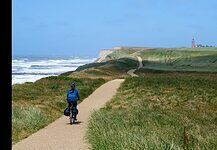Travel to Portugal
Portugal is situated on the Atlantic shores in the far South Western side of Europe’s Iberian Peninsula. The country is fortunate enough to have long stretches of glistening coastlines along with beautiful mountains and hills in the interior. This, matched with medieval castles, cobblestone villages and bustling cities make Portugal an exciting European country to explore.
Along with this idyllic scenery, you’ll also find great history, eclectic cultures and great food. Portugal highlights include eating your way through Lisbon, relaxing on the stunning beaches of the Algarve, sailing the River Douro from Porto, cycling or hiking along the Sintra mountains and exploring the green hillsides of the volcanic Azores.
The vibrant cities in Portugal include Lisbon and it’s northern sibling Porto – both gems to explore. Both cities include narrow hillside streets with trams heading up and down, bohemian cafes, buzzing plazas, busy restaurants and an exciting nightlife scene. No trip to Portugal is complete without visiting its cities.
The best time to visit Portugal is during their Spring (March – May) and Autumn months (September – October) – the weather is warm, hotel rates are lower and there are fewer crowds. The summer months (June – August) can get quite hot and really busy with crowds. If you want to experience Portugal in the summer, then book a trip in June as you might also be able to join some of their annual festivals.
Our Portugal travel guide will share the best places to stay in Portugal, the top Portugal holiday destinations, Portugal transportation and all other general information about traveling in Portugal.
Visa Requirements for Portugal
Portugal is part of the Schengen agreement, which allows most of the EU citizens to enter the country with only their ID. When entering by air from a non-Schengen country, you will be expected to fill out a brief form which includes an address in Portugal. You can just use the address of your hotel. It’s very unlikely that this will be checked, but you will have to enter an address if you want to enter the country.
Visitors from certain countries like the USA, Canada and New Zealand can visit visa-free for up to 90 days in Portugal. A stay of longer than 90 days for non-EEA or non-Swiss citizens usually requires a visa, which you need to get before your trip. Note that Portugal is less lenient on longer stays than other European countries.
Other nationals, like those from Russia, Asian countries and Africa, will need to apply for a Schengen Visa before arriving in Portugal.
To make 100% sure what you need for your Portugal visa application, visit this website.
Important Cultural Information
While Portugal remains being one of the EU’s weakest economies, it is a remarkably unified country. There are no minorities fighting for independence, and the rivalry between the north and south is little more than light mockery.
It’s also, generally, a very tolerant nation with an integrated community with a population from its former colonies in Africa, Asia and Brazil. Modern Portuguese tastes are heavily influenced by the styles and flavours from Angola, Mozambique and Brazil.
Portugal is a Catholic country. While you will find ancient churches all over the country, the support of the Church has waned, though the traditional values remain. Portugal has embraced a modern lifestyle without getting rid of the more appealing aspects of previous centuries.
Portuguese is the official language in Portugal. This differs from Brazilian Portuguese, it is understood, but not used in Portugal. You will get by with English in the major cities and tourists spots like the Algarve – but may battle a bit in the smaller villages.
Banking & Money in Portugal
In Portugal you pay with the Euro (€), just like in other 24 European countries. 100 cents makes up 1 Euro.
Each country can produce their own Euro coins, where one side of the coins has their own unique designs, while the other side has a European standard design. You can use the Euro in any of the eurozone countries, without needing to exchange money when crossing the borders.
To exchange money, there are plenty of ATMs, where you can withdraw up to €500 (some may only allow up to €200), usually for a fee, depending on your own bank conditions. ATMs are called Multibanco’s in Portugal. ATMs are multilingual, so you shouldn’t have a problem with using them.
Credit cards are well accepted all over. But it’s always useful to have a few Euro notes, especially in the countryside or for tipping at restaurants.
Medical Emergency Information
If there is an emergency, you can call 112 from any phone at no cost. This will get you in touch with the police, firefighters and ambulances.
The number for the Sea Rescue in Lisbon is 214 401 919.
If you’re looking for travel insurance, we are an affiliate of World Nomads.
Wi-Fi and Internet in Portugal
There are three network operators in Portugal: MEO, Vodafone and NOS. Vodafone is the most recommended for travellers, while MEO probably has wider coverage. All three networks offer LTE to prepaid customers on the 800, 1800, and 2600 bands, along with 3G/HSPA+ on the standard 2100 band used throughout Europe. Coverage is generally good throughout Portugal.
You will find several shops selling SIM cards around Portugal, including in the smaller towns. Getting a prepaid SIM in Portugal is very easy. Most places won’t even ask you for your passport or an address – though, have these ready just in case.
Another option is to rent a mobile MiFi device, your own hotspot. Those costs from around €5 per day. There are services, which you can pick up at the airport or which gets delivered to the hotel you are staying at.
Wi-Fi is easily available at hotels and many coffee shops. Look out for ‘Wi-Fi’ or ‘@’ signs on the doors. You may also find other free Wi-Fi spots throughout the main cities in Portugal. Make sure to set-up a VPN (like ExpressVPN) before using public Wi-Fi spots.
Coworking in Portugal is also popular, with major coworking spots in Lisbon and Porto, along with a few in Sao Miguel and Cascais.
Arrival in Portugal
You will likely arrive in Portugal via the Lisbon Airport – named Humberto Delgado Airport. This airport is the main international gateway to Portugal, located 7km outside of Lisbon. Almost all major airlines fly to Portugal (including British Airways, Air France/KLM, Lufthansa, United, American, Turkish, Emirates, Air Canada, Iberia etc), along with the country’s own TAP Portugal and SATA/Azores Airlines.
Other international airports in Portugal include Porto/Pedras Rubras/Sá Carneiro in Maia and Faro in the Algarve. The Azores and Madeira Islands also have international airports: Madeira/Funchal, Ponta Delgada (São Miguel island); Terceira/Lajes.
Check Expedia for available flights to Portugal.
If you’re coming from other European countries, then arriving in Portugal via train is also an option. Trains reach most larger cities – including Lisbon, Porto, Braga, Coimbra, Evora, Aveiro and Faro. Lisbon is connected to Madrid in Spain. It’s not possible to enter Portugal via Spain in the south as there are no train connections eg. from Sevilla to Faro.
You can of course also enter Portugal via bus or by car from Spain. If traveling to Portugal by car, check out Europcar for car hire. ALSA and Auto Res offer bus routes between Spain and Portugal.
The country is served by numerous sea ports that receive a lot of foreign traffic – particularly from Morocco.
Areas of Portugal
Some of the best places to visit in Portugal are the cities in Portugal – Lisbon and Porto. These two cities are packed with Portugal must sees – featuring some of the countries best clubs and most adventurous modern architecture.
The inland areas feature wine estates, walking and hiking opportunities, cycling and kayaking.
The coastline is also a major Portugal highlight – from its sheer cliffs through to endless stretches of sandy beaches.
Here are the main areas of Portugal:
Northern Portugal
Northern Portugal is a historic region, considered the birthplace of the nation. Here you will find the second largest city in Portugal, Porto. Porto is most famous for its port wine. While in Porto you can sample a myriad of port along with taking tours of the cellars and learning more about the history of the wine. There’s also the waterfront of the Ribeirinha Promenade and the beautiful River Villa de Gaia.
The surrounding region of the Douro Valley is also great to explore – mostly to find where the grapes are grown!
Much of the West coast of Portugal is a haven for surfers because of the Atlantic’s high rolling waves. The closest beaches to Porto city is Praia de Matosinhos and Praia do Ourigo – both within a 20-minute metro ride. Other great beach towns include Miramar, Granja, Francelos and Espinho. All within a hour on public transport from Porto.
Lisbon
South Central Portugal features the capital city, Lisbon, along with Estremadura and the Upper Alentejo. Lisbon is one of the most ‘best-value’ cities in Western Europe. The city is packed with culture, historical sites, cobblestoned hilly streets and friendly locals. The food and vibrant nightlife are also what attract many visitors to the city.
The Algarve
The Algarve is the most visited region in Southern Portugal, along with Lower Alentejo. Some of the best beaches in Portugal include Sagres, Aveiro and the Praia da Adraga. There’s a beach for everyone along the Algarve – including some for swimming, sunbathing, surfing and hidden beaches. Albufeira is the main tourist destination in the Algarve, while Faro is the administrative centre of the Algarve.
Azores
The Azores are an archipelago in the mid-Atlantic – an autonomous region of Portugal. The islands are characterized by dramatic landscapes, green pastures, fishing villages, and hedgerows of blue hydrangeas. São Miguel, the largest island, has lake-filled calderas and the Gorreana Tea Plantation.
Madeira
Another autonomous region of Portugal, Madeira is an archipelago of four islands off the northwest coast of Africa. This region is known for its wine and warm climate. Madeira’s main island is volcanic with green and rugged high cliffs and pebbly beaches. Funchal, the capital, has beautiful gardens and is popular for its harbour and New Year’s fireworks.
Transportation in Portugal
Rail travel is slightly faster than the bus in Portugal – though not as fast (or frequent) as other European countries. Comboios de Portugal operates all trains. The areas around Lisbon and Porto, however, are well-served by the suburban rail services. You can easily travel find a Porto to Lisbon train, but the smaller towns are less likely. The Alfa-Pendular (fast) trains stop only at main stations – between Braga, Porto, Gaia, Aveiro, Coimbra, Lisbon and Faro. Intercity trains will travel further. If you are going to be traveling long distances in Portugal by train, it may be worth considering getting the Portugal Rail Pass.
Alternatively, Rede Expresso is one of the largest inter-city bus companies in Portugal – also traveling the Lisbon to Porto route.
Lisbon and Porto both have a clean, modern and air-conditioned metro systems (underground/subway and light railway). Find the Lisbon metro map here and the Porto metro map here.
Busses also form a big part of public transport throughout Portugal, in the big cities and smaller towns.
Portugal’s iconic trams are a big part of Lisbon public transport. While many have been replaced, some of the old rickety wooden trams are still in use. Most visitors will take the Tram 28, which goes though some of the city’s most touristic and scenic areas.
Additional Lisbon public transport are the furniculars that help climb the city’s steep slopes. An example is the Santa Justa Lift – an elevator in Lisbon that is the fastest way to get from the Baixa neighbourhood to the Bairro Alto district.
Look into getting the 7 Colinas and Viva Viagem cards for accessing the Lisbon public transport – you can get these Lisbon cards from the metro stations, newspaper stands or Carris’ points of sale.
Accommodations in Portugal
Portugal is relatively inexpensive compared to the other European countries. You can probably go for something a bit fancier than your budget would normally allow when looking for accommodation in Portugal.
A variety of options are available, from the lower end budgets including hostels and budget hotels through to luxury hotels, entire apartments and villas.
An unique accommodation option are pensão – family-run inns. On the luxury side, you can check out ‘Pousadas de Portugal’ – a network of hotels that are managed by the Pestana Group. They are renowned for using ancient buildings like castles and palaces along with having great service and consistent offerings.
Some of the best places to stay in Portugal include Lisbon, Porto, and along the Algarve coast. You will generally find a high standard of accommodation in these main areas along with a large variety of options.
The best places to stay in Algarve include Lagos, Albufeira or Praia da Rocha – all great Portugal holiday destinations.
The best neighborhoods to stay in, in Lisbon include Baixa and Chiado (historic centre), Alfama (the oldest quarter), Avenida da Liberdade (shopping district), Bairro Alto (for nightlife) and Cais do Sodré (hip and happening). Read our Lisbon neighborhoods guide.
If you’re traveling during peak season or holidays, it is best to book your accommodations in advance. We recommend searching for accommodation on Booking, Agoda, HostelWorld or Expedia.
Food & Dining Guide for Portugal
Portugal is all about Mediterranean cuisine. Portugal food features hearty meals with fresh and organic ingredients. Besides from the hearty meals, you’ll also find loads of fresh seafood from the West and South coasts. You can’t really go wrong with Portuguese food.
While there are so many different foods to try in Portugal, if you’re only there for a short time, make sure to try out the below foods:
- Bacalhau A Bras: Cod is an extremely popular food in Portugal. Bacalhau A Bras is shredded cod sautéed in pan served with fried potatoes, onions, eggs, garlic and parsley.
- Alheira: This ‘sausage’ is usually served with fried egg and fries. You can find many different kinds in the various corner eateries in Portugal.
- Arroz de Cabidela: Translated as ‘chicken blood rice’ – don’t think too much while eating this dish. It involves cooking chicken in its own blood, creating a rice dish that is rich, full of flavour and delicious.
- Caldo Verde: This is a Portuguese soup featuring a mix of potato, onions and kale cooked with garlic and olive oil. Great for a cozy day or when you need a comfort dish.
- Arroz Doce: Onto the desserts, this traditional Portuguese dessert will satisfy your sugar cravings. It’s a sweet and creamy egg-based rice pudding, made with caramel custard and a bit of cinnamon.
- Pastel de nata: You will want to have this Portuguese custard tart for breakfast everyday (and not just one!). They originate from Lisbon and the best places to try them are Pasteis de Belém, Manteigaria, and Aloma.
Drink-wise, Portugal produces some of the best wines in Europe and is the birthplace of Port, a fortified wine.
Our top Portugal foodie tip is to visit the Time Out Market in Cais do Sodré in Lisbon. This market hosts stalls from some of Lisbon’s best restaurants, allowing you to taste some of the best foods to help decide which restaurants you’d like to enjoy a full meal at.
Here’s how to order coffee in Portugal.
What to eat & drink in Portugal
Portugal’s Attractions
Lisbon is a major Portugal highlight – this city makes its visitors fall in love and want to return again and again.
Things to do in Lisbon include watching a fado performance (a unique style of traditional Portuguese song), go miradouros hopping (amazing viewpoints across the city – you’ll find them signposted) and joining in the new Lisbon bike-sharing scheme. Other Lisbon sites include the National Pantheon, Sao Jorge Castle, Santa Catarina and the tower of Belem.
We recommend getting the Lisbon Card for free access to Lisbon’s top museums and attractions – including Torre de Belem, Jeronimos Monastery and the Santa Justa Elevator among others. You can get either the 24, 48, or 72-Hour Pass – get it here.
Check out our itinerary for exploring Lisbon in 2 days!
Apart from Lisbon, there’s also so many things to do in Porto – a UNESCO heritage town. In Porto you can explore the Ribeira District, relax on the Douro River Promenade, admire the Dom Luís I Bridge, go port wine tasting in Vila Nova de Gaia, join a cruise along the Duoro River, go on a trip to the Duoro Valley or climb the Arrábida Bridge. For Harry Potter fans – Porto was home to the author between 1991 and 1993. You can visit some of the cafes that JK Rowling spent time writing the book series (including Café Majestic and the Livraria Lello bookstore).
You can also get a Porto Card that includes public transport in Porto along with access to museums and attractions – including a free visit to a port wine cellar! Get it here.
Surfers need to head to the Western coast. Nazare, a former fishing village, boasts the largest wave ever surfed! Wine lovers need to head to the Dao Valley.
Heading to Faro? Here’s a few things to do in Faro with kids.
Things to do & see in Portugal
Shopping in Portugal
While most cities and larger towns will have a shopping centre with most local and international brands available, a lot of the locals generally still do most of their shopping at smaller shops and markets. A town’s mercado municipal (municipal market) is the place to buy meat, fish, fruit, veg and bread. You will find these types of markets open daily, with larger markets happening weekly.
If flea markets is your thing, then you’ll love Lisbon. The most famous flea market in Lisbon is Feira da Ladra. It’s been in operation since the 12th Century – making it among the oldest markets in the world. You can pick up some great antiques and collectibles here – it is open on Tuesdays and Saturdays.
For quality designer clothes, you have to head to the fancier malls or larger city centres like Lisbon’s Avenida da Liberdade (for international names) or the Bairro Alto (for local cutting-edge styles).
Souvenirs to buy in Portugal include ceramics (from traditional azulejo tiles to elaborate figurines, cookware and sculptures), carpets, rugs, blankets, tapestries, linen and lace. It’s also nice to get some of Portugal’s great wines and food products to take home – port, olive oil, honey, cheeses and hams (make sure to get them vacuum-packed).
Nightlife
Portugal comes alive at night – particularly in the summer months in the cities of Lisbon and Porto. Bairro Alto is Lisbon’s main nightlife area. It’s a maze of narrow streets with tiny bars and restaurants serving beers and caipirinhas. Expect your drink to be served in a plastic glass – meaning that you can take them out onto the streets.
In Porto, the Ribeira District overlooking the River Duoro is the best place for fun, while Matosinhos and Vila Nova de Gaia are great areas for nightclubs. You’ll also find a lively student nightlife scene in the cities of Braga, Coimbra and Evora.
You will find a choice of bars, restaurants and nightclubs throughout Portugal. Start off the night sipping on sundowners while watching the street life go by at the cafes and bars, followed by a delicious dinner and later possibly some dancing.
Let the night take you away – you will definitely come across something fun.
Safety Tips for Portugal
Portugal, like most of Europe, is a safe country.
Petty crime, like pickpocketing and mugging, is the only real risk – especially in the major cities and tourist hotspots. It’s always best to remain aware at all times. Keep your valuables safe and remain extra alert when in big crowds. Pickpockets have also been known to hop onto Tram 28 in Lisbon as they know that it’s full of tourists – so keep your bags close.
Conclusion
Portugal is an awesome choice to start off your European travels. Being located at the far western side of Europe it’s easy to start here, and slowly make your way through the other Western European countries. It’s also one of the most affordable, making it easy for most travelers’ budgets.
Portugal is absolutely beautiful, from it’s out-of-this-world Algarve coastline scenes through to the mountainous interior, wine regions and hilly and red-roofed cities.
The food is hearty, fresh and delicious, the locals are accepting and friendly, accommodation options are abundant and there is so much to explore!
What are you waiting for? Start planning your holiday in Portugal today!















































